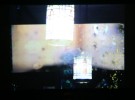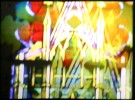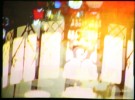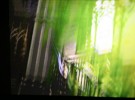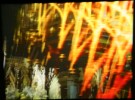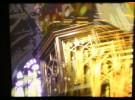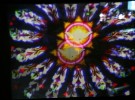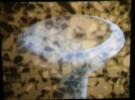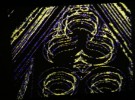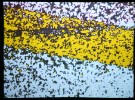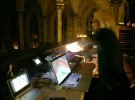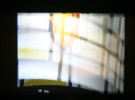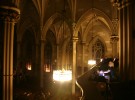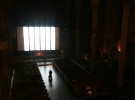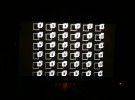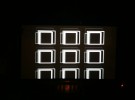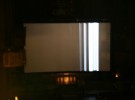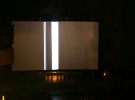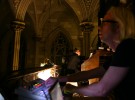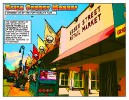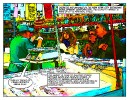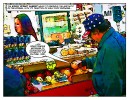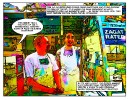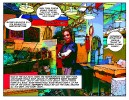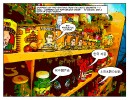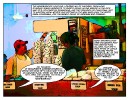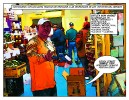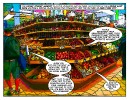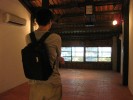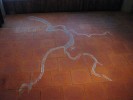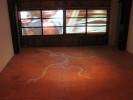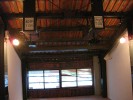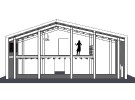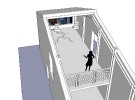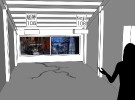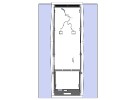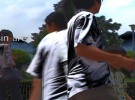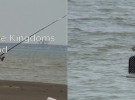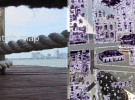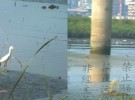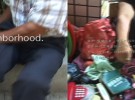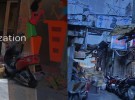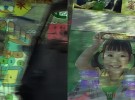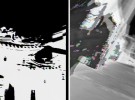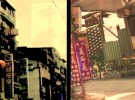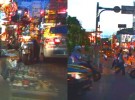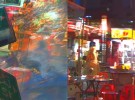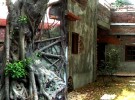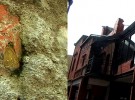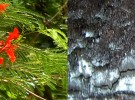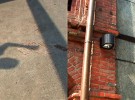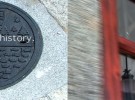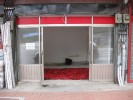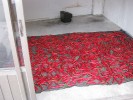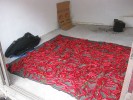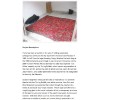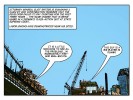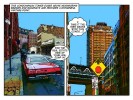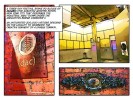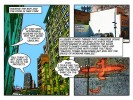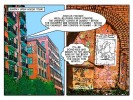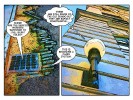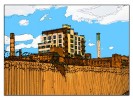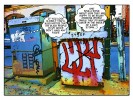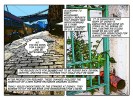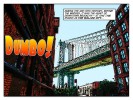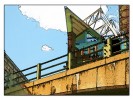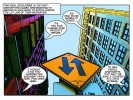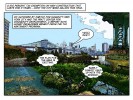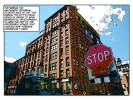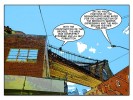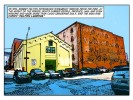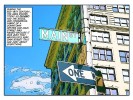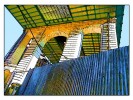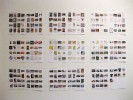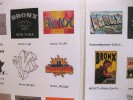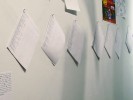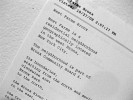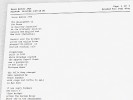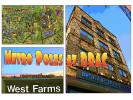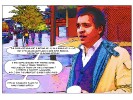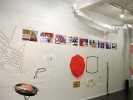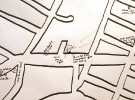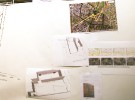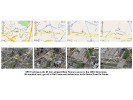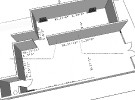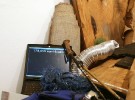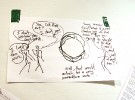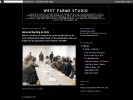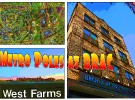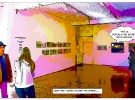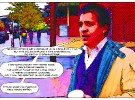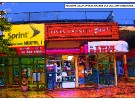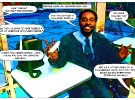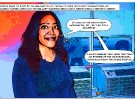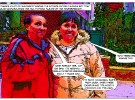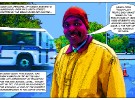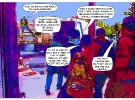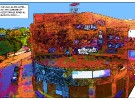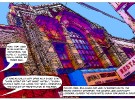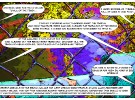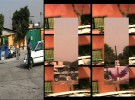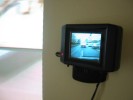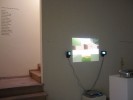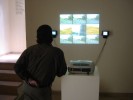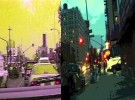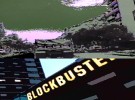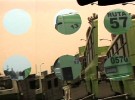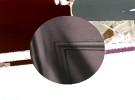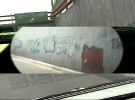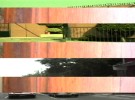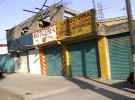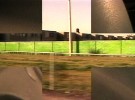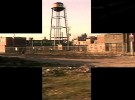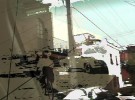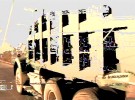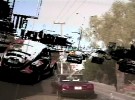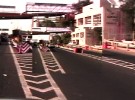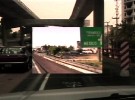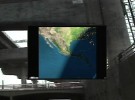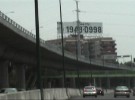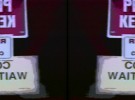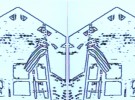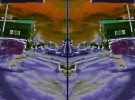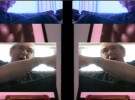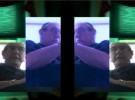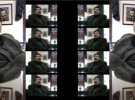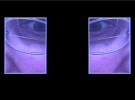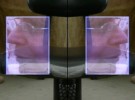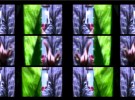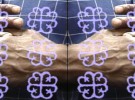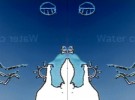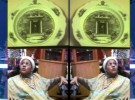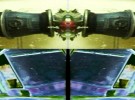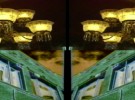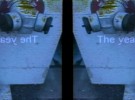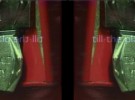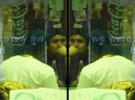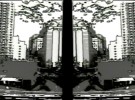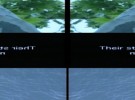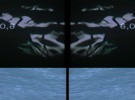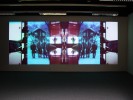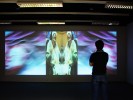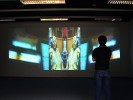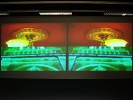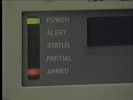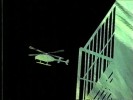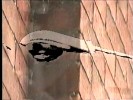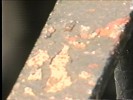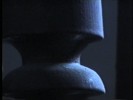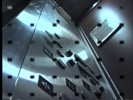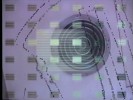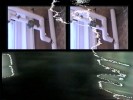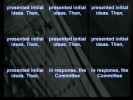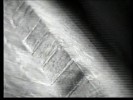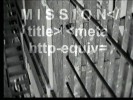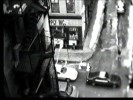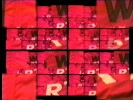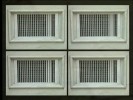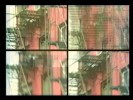720p, 29.97fps, 41 minutes and 45 seconds, two channel video installation, projected on a 107″ x 432″ roll of Super White Set paper.
One of the artworks in Paul Clay’s solo show entitled “Sketches and Memories, (synthesized compositions rendered later, upon the artists’ safe return home)”, Part of the Hudson Vally Center for Contemporary Art’s Peekskill Project V, at ArtWestchester’s The Arts Exchange Building, White Plains, NY, 2013.
Through and invitation from Livia Straus, President of HVCCA, and organized by curator Kianga Ellis.
Painters of the Hudson River School traveled to rather remote natural locations where they made sketches, studies and gathered visual memories, but then trekked back to the safety of their homes (and studios) to make the paintings, often combining elements from a variety of different locales into a single synthesized composition. My title for the exhibit is an oblique reference to this practice.
“Sketches and Memories…” is a collection of works addressing the history of Peekskill and White Plains New York, as well as that of the entire Hudson River Valley. The works combine the subjective and personal with larger forces, tracing geology, prehistory, international politics, and global cultural diffusion to tell the story of the region.
Installation Photo:
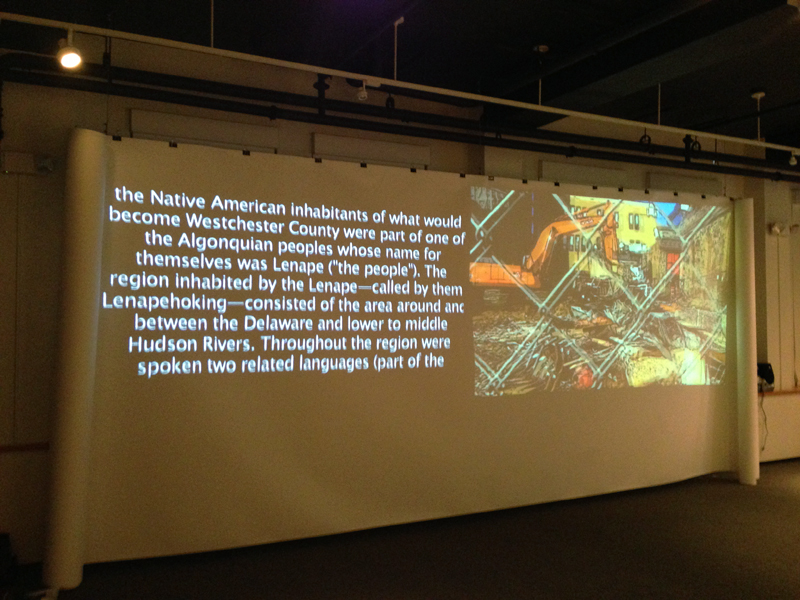
Video Excerpt (4 minutes, 30 seconds):
Project Description:
The video artwork “White Plains Story” incorporates subjective bits of White Plains history from interviews and personal experiences, and also looks at the connection between White Plains and New York City, told in the form of a cartoon, collage or animated comic book, and a long scrolling text. The two channels are projected onto a 9 foot high by 36 foot wide roll of white paper, scrolled up at both left and right ends to create a 22 foot screen.
One video channel projects scrolling text, like one might see at the end of a feature film, but instead of credits, the text tells the history of the White Plains area. It involves three sections or chapters. The first covers the history and language of the Native American Lenape who lived in the region for thousands of years, and the Wappinger confederacy who interacted with European arrivals mostly from the 1600 to 1800’s, along with the Weckquaesgeek, band who lived in what was to become White Plains. The second section covers the history of the Arts Exchange Building, where ArtsWestchester is based, and the third, the history of what European settlers referred to as “the white plains”, from the first non-native settlement in 1683 right up to the present.
A second video channel also projects three sections. The artists trip from New York City up to White Plains, a sit down interview with Kathleen Reckling, Gallery Director of ArtsWestchester about her work and her life growing up in the area, and a driving tour with local resident David Licata through various neighborhoods of the city. This second channel is in the form of a cartoon, shot entirely on an iPhone with the ToonCamera app, to convert the video into the visual look of cartoons, and then edited and enhanced in Final Cut Pro.
Both channels are projected onto a 107 inch by 36 foot long roll of Super White Set or photo background paper, evoking the notion of pages in books, and comic books in particular, while at the same time suggesting scrolls which might contain histories or panoramic landscapes. It also references the technology of acetate film with the ends curled up, and the giant binder clips which hold it up the paper screen spaced along it like sprocket holes.
The two video channels, running concurrently, one historical text, the other lush colored cartoons telling personal stories, cause the viewer to jump back and forth between competing narratives, past and present, suggesting a continuum of reality about the region, which must be parsed and filtered to make sense of. All of the disperate competing truths coming together to suggest one possible White Plains Story.
Live video projection working with a series of different musicians. Presented at St. Patricks Old Cathedral, New York, City. This was part of “FlashLight” an event put together by Nuit Blanche New York, in conjunction with the New Museum’s Festival of Ideas for the New City, May 7th, 2011
Project Description:
This was a kind of visual jazz style improvisation in which I pre shot content at the Cathedral, and then mixed it live along with video from a live camera, to create a set of moving images in time to the music, and evoking qualities in each of the musical compositions. The visuals were projected on a huge screen stretching across the the altar area. Content included close ups of stained glass, and of architectural details of the church itself. The live video mix was accompaniment to the following music:
Aaron Siegel – Common Tones
One of the fundamental elements of musical counterpoint is the idea that movement from one chord to another is facilitated by the presence of some of the same material in both chords. Common Tones explores this idea using a limited amount of information deployed slowly over the course a performance. The structured improvisation will be performed by Basilica Music Director, Jared Lamenzo.
Matt Marble – Way Up in the Middle of the Air
Way up is a work of scored improvisation for organ + ensemble (trb, bsn, acc, 2 b., & prepared synth). Inspired by Ezekiel’s fantastic vision in the Old Testament, wherein he sees 4-headed cherubs tied to crystalline gyroscopes, all supporting the glass throne of a divine chariot… way up is a sonic meditation on the vehicle of ascension. Simply put: Dream on & Levitate.
Pilottone – Flash:Remix
Pilottone will present a performance and intervention in which the group will stage and remix… as they repurpose sounds collected earlier in the evening during the Festival of Ideas.
Representation, a Chronicle of the Essex Street Market
Paul Clay, 2009
A series of 44″x66″ digital prints on archival 100% cotton paper, using historical research, oral history, and the representational form of a comic book, to chart the sociocultural development of the Lower East Side through the story of the Essex Street Market.
A selection of the pieces will be on display, starting with the opening reception Saturday, December 12th, from 5pm-7pm in the North End of the Essex Market, 120 Essex St., New York City, and the exhibit will run through January 2010.
This project is made possible, in part, with public funds from the Manhattan Community Arts Fund, supported by the New York City Department of Cultural Affairs and administered by the Lower Manhattan Cultural Council, and with generous support from The New York City Economic Development Corporation and the Department of Small Business Services.
Project Description:
The comics are made from photos of actual people who work in and frequent the market,and include text in multiple languages, with both historical data, and information from oral histories, capturing a snapshot of a vibrant and volatile historical moment.
The Essex Street Market is a long standing center of everyday culture in the Lower East Side. It is unique on many fronts: for the products available, the atmosphere of the place, its inherent support for rapidly disappearing craft practices, and its tradition of multi generational handing-down of family business lore. Also, by its very layout, it supports high job density and the preservation of the aesthetic of the bodega, with its tradition of daily food purchase and simultaneous exchange of neighborhood, community and cultural information. The Essex Street Market is a vital business and cultural institution in the Lower East Side and this artwork highlights its special place within the community and the culture of New York City.
The neighborhood contains a diverse mix of cultures, from long standing Jewish residents to Puerto Ricans having arrived in the 60’s and 70’s, followed by Dominicans, and the expansion of Chinatown, not to mention local artists who settled in the area back when the rents were affordable, and the recent influx of Japanese and Koreans. Rapid gentrification over the recent past has created huge cultural flux and a wide range of levels of income among residents.
A 90 minute two channel video art installation, involving video projection on paper covered windows in a 100 plus year old Chinese warehouse building, Chalk floor drawing, signage, and lighting.
Presented as part of “Fusion Folks – Contemporary Art Exhibition” Organized by the Taipei Department of Cultural Affairs and planned by Taiwanese independent curator Mr. Sean C.S. Hu. 24 artists both Taiwanese and international, create works related to the Bo-Pi-Liao Historic Center, in the Wanhua District, creating closer ties between art, history, and local customs. Taipei City, Taiwan, from 8/29/09 to 11/01/09.
Installation Photos:
3D Model of Installation:
Video stills of both Channels:
Video Documentation:
[tubepress video=”I5ZJ6oMCwF0″ embeddedWidth=”610″ embeddedHeight=”380″ length=”true”]
Project Description:
Mengjia-108, is a two channel video installation which explores the complex multicultural history of the Wanhua District, in Taipei City, a site of continuous human habitation along the Danshui River, for thousands of years. The title of the work refers to an ancient name for the area, along with the current postal code number. Â Wanhua’s long history and its contemporary status are thus juxtaposed in simultaneous existence. The work employs collage, video filter effects, and text overlay, to present images of past and present, as well as differing viewpoints, angles, and cultural perspectives.
Taiwan has been inhabited for perhaps tens of thousands of years, and the first people in the Taipei basin area arrived around 6000 years ago. These first peoples, or first nations, formed a robust river and seafaring culture. Both they and their language eventually spread all across the islands of South Asia and the Pacific, as far as New Zealand and even the land of the current United States of America. Due to lack of written records and in the absence of large scale architectural remains in long lasting materials, this monumental technological and cultural achievement has garnered little recognition.
Starting in the 1600’s successive waves of peoples including the Spanish, Dutch, Japanese and Han Chinese took control of all or parts of Taiwan, each leaving their mark on its cultural heritage. Throughout this history the Danshui River, and the Wanhua District area have played a major roll.
Wanhua has been an important harbor and trading site for thousands of years, and Mengjia-108 traces some of the disparate viewpoints and little known truths about the area. The Wanhua district has a proud and complex multicultural past, appreciation of which can serve as a guide to the shaping of its future.
Sun Dried Boys (Red Pepper Found Installation), Paul Clay, 2009
Presented in conjunction with (but not associated with), the 2009 Incheon Women Artists Biennale, Incheon Korea.
Multimedia work. Text description, digital photos of storefront installation with red paper-covered windows, television set, red plastic wash basin, flattened cardboard box, two black nets, drying red peppers. Dimensions variable.
Project Description:
Sun Dried Boys starts with a “found installation” or readymade in the form of something already existing, that looks for all the world like an art installation.
The space is photographed and then explicated at length, putting the “installation” in context within the contemporary art scene. The actual artwork consists of the photographs and the text in the form of a fictional “Project Description”. In one way such a work could simply be read as prankster art, but the real intent is to use the found space as a lens to view the art context of which the installation is supposedly a part.
Sun Dried Boys thus explores the social network around the 2009 Incheon Women Artists Biennale, acknowledges folk art and undervalued women’s practices, rips-off or riffs-on, the exploration of other artists work during the exhibit, and acknowledges the gendered power structures that still exist in society and in the contemporary art scene.
The artwork can be viewed at the following url:
http://sundriedboys.blogspot.com/
Two works from this series appeared in the group exhibit, “Anthropology: Revisited, Reinvented, Reinterpreted”, at Central Booking, Brooklyn, NY, November 2009. The work is intended to explore the Brooklyn neighborhood of Dumbo, and is available in two forms:
As individual 44″ x 66″, or 22″ x 33″ prints, archival ink, on acid free 100 percent cotton paper.
As individual images without text in the form of 38″ x 54″ archival ink prints on canvas.
Project Description:
Dumbo Comic (Print Work) takes 30 Washington Street as its starting point, to explore Dumbo’s unique history, and its architectural and sociological development. The artworks, in the form of comics, take inspiration from the factories built along the East River waterfront, and from Robert Gair’s position in the end of the 19th century as an inventor involved in industrial printing, cardboard box manufacturing, and real estate.
The work includes reference to the idea of the “Walled City”, a nickname for Brooklyn in the time before the bridges, when there were so many warehouses along the river that it created the look of a walled fortress from the water side. The name can also be interpreted as a reference to the subsequent isolation that Dumbo suffered from, following the construction of the bridges and the Brooklyn Queens Expressway. The bridges and expressway not only made it hard to pass directly into Dumbo from the rest of Brooklyn, but also, because of the length of the exit-ways off of the bridge actually made all the Brooklyn/Manhattan traffic bypass Dumbo, traveling several stories above it. This (at first) tragic walling off, ultimately helped to preserve many of the historic qualities of the neighborhood which are valued today.
Dumbo, New York City’s 90th historic district, is bounded by John Street to the north, York Street to the south, Main Street to the west and Bridge Street to the east, and includes 91 buildings that reflect its industrial heritage. The Brooklyn waterfront region was one of the premier industrial areas in the United States, and at the turn of the 20th century, Brooklyn was the fourth-largest manufacturing center in the country.
Dumbo Comic (Print Work) looks at the historical development of this area through the use of line drawing, and the comic. The line is a simple yet powerful visual tool. Greek legend has it that the first drawing originated from someone using a stick to copy shadows in the sand, and line drawing has long functioned to allow a kind of caricature, or portrait of a person or thing. Comics use a simplified, or iconic visual language to explain complex ideas and narrative structures – a kind of “amplification through simplification”. The form tends to be democratic in nature, and readily accessible to a broad spectrum of society.
The origins of the modern single frame political cartoon can be traced to Britain in the 1800’s and is distinguished by the use of caricature. Throughout much of the United States’ history, political cartoons have held a prominent place. In the Civil War era, Thomas Nast invented the “Donkey” and “Elephant” that remain today the standard signs for the Democratic and Republican parties. They help us focus on the metaphors used in societal discourses.
Comics (or multi-frame cartoons) developed in the late 19th and early 20th century, alongside the similar forms of film and animation. The history and development of comics is directly linked to the development of 19th century manufacturing, to newspapers, and to the re-invention of printing as a large-scale industrial process. Robert Gair was a part of this movement, and the development of serial frame comics was happening at exactly the same time he was building “Gairville” in what is now Dumbo. Further, Gair’s newly developed process of industrial printing on cardboard, and his industrial production system for cardboard boxes was likely inspired by newspaper industrialization. Gair’s former factory was located in Manhattan near the Puck building, an historic area in the development of industrial printing.
Dumbo is a place of outsized architecture. Everything is at the scale of elephants or super heroes. In addition to its rich history, it is currently the site of some of the most intense gentrification in New York City. In Dumbo Comic (Print Work) the neighborhood and the buildings themselves are characterized through the visual language of the comic book, in order to provoke thought on issues of urban planning, quality of life, and the visual impact of the street level built environment. The project acknowledges the scale of the area and the special place which architecture and development holds here.
Methods:
Dumbo Comic (Print Work) consists of two series of works with images starting from 12 megapixel digital stills shot on the streets of Dumbo. These images are then individually run through a variety of different types of desktop printing software and extensively reworked and elaborated, resulting in a set of “Technicolor” schemed cartoon prints, capturing architectural detail, and the street level build environment.
Text has been added by doing a Google search for the word “Dumbo” and culling bits of text and actual quotes from the search results. Part of the byproduct of this method is that elements of text treating the 1941 Walt Disney Animated feature by the same name also make their way into the work, serendipitously adding to critique of issues within the neighborhood.
Working with the form of the comic, this project attempts to provoke thought on issues of urban planing, quality of life, and visual impact of the street level built environment.
Presented at the Bronx River Art Center as part of the goup exhibit Metro Poles, Art in Action, a curatorial collaboration between tne Jamaica Center for Arts & Learning (JCAL), the Bronx River Art Centre (BRAC), the Asian American Arts Center (AAAC), and the Maiden Lane Exhibition Space. The work is intended to explore the Bronx, the neighborhood of West Farms, the area’s relationship to the gallery, and the premise of the exhibit.
Here is the comic, in its entirety:
Â
Project Description:
Because this group exhibit is intended to focus on process, blur lines between artworks, and reduce the primacy of the individual artist in favor of a loose integrated net of creativity that blankets the entire gallery – even the act of writing a statement about the individual work could be seen to detract from the exhibit’s mission.
What follows is therefore, not a concise statement but rather a description of participation.
In the spring of this year I was invited by Jose Ruiz, curator of Bronx River Art Centre (BRAC) and Heng-Gil Han, curator for the Jamaica Center for Arts & Learning (JCAL), to submit responses to a set of questions.
They were asking a variety of artists to respond to the idea of an exhibit where artists would make work in a gallery setting and then have it subsequently altered by others. Among the questions asked were: “What contribution can you make to this unconventional exhibition?”, “Can you allow other artists to revise your installation?”, and “Who would be other artists that you would like to invite to the exhibition for the revision and collective art-making?”
The resulting exhibit: “Metro Poles, Art in Action”, is a curatorial collaboration with Jamaica Center for Arts & Learning (JCAL), the Bronx River Art Centre (BRAC), the Asian American Arts Center (AAAC), and the Maiden Lane Exhibition Space.
Â
Among the things I wrote back in my initial response were the following:
“I will photograph in or near the display space – i.e. nearby buildings, back yards, whatever. The available views will function as a filter or organizing principle. This will become the target of research.”
“I will then go out on the street and find anecdotal information from passersby (as well as from people employed by the art institution) regarding who lives there, what business is conducted, what events have been witnessed etc.”
“In a third step I will do further historical research about the visually identified locations on-line. I will then make a collage from the various information materials, printed with ink jet, in a variety of sizes and textures of paper and post the information on the galley walls, like fliers or even gorilla-style like paper street art.”
“All this material, both the physical printing on paper and the conceptual structure surrounding it would then be available as raw materials to use by subsequent artists in any way they see fit. I would simply hope they might function as a launching off point of interest in the creative process going forward.”
I also invited artists Chang-Jin Lee, Marcy Brafman, and Ã…sa Elzén to be “team members” for our group, one of seven groups to work in the space.
For my part I ultimately adopted six strategies, relating to my initial proposal that were designed to explore the Bronx, West Farms, (the neighborhood where BRAC is located), and the area’s relationship to the gallery and the mission of the exhibit.
Â
Strategy One: Gathering images based on a net search for the word “Bronx”
This was a way to begin to understand the visual history in relation to what people have recorded on the internet, about the Bronx.
This doesn’t constitute a comprehensive compendium of visual material for two reasons. First, many things visual known and recorded were done by people prior to the world wide web and those people tend to be less connected, and thus fail to get their visual info recorded to a web readable format, and posted. As a result, much of this human visual archive is missing from a current search.
Secondly, visual searches are still in the dark ages of technology, or in their infancy. Most digital visual images must be “tagged” with text either in their name, metadata (invisible information attached to the digital visual file) or through some similar structure, in order to show up in a search. Smart search engines may also give some weight to images on web pages titled with the search term or in which text containing the term is laid out in close proximity to an image, but this is obviously a tricky mix to accomplish successfully and thus leaves out much of the valuable information that actually has been posted, but hasn’t yet been tagged.
There are algorithms (the most effective of which are currently mostly available only to large corporations), which can search for the actual visual elements of an image, or its genuine “mediatic criteria”, such as color, luminance etc. These can find an image no matter what it has been tagged, but even these currently cutting edge technologies can only look for an image once they already have a base image to compare, so they can find close matches, but only to images they already know about.
All this means that right now, doing a visual search on the Bronx yields a strikingly limited set of results. Nonetheless, it begins to tell some stories about what people, corporations, and organizations valued enough to tag and post.
To display I printed a selection of the results, 16 images to a page, on 8 1/2″ x 11″ ink jet paper, along with the name of each file displayed below it, on 18 pages, and taped them to the gallery wall, much as I might do in my studio.
Â
Strategy Two: Download text related to the history of the Bronx and the neighborhood of West Farms.
I chose 9 of the most compelling texts among many dozen I had saved, formatted them in a formal structure designed to be reminiscent of poems, and pinned these to the wall.
In most cases, the written work was stripped to ASCII text, every comma was removed and converted to a carriage return, and every period was removed and converted to two carriage returns, to create text block separations, and finally the entire text was hard wrapped to 35 characters, to produce short phrases. I did a bit of clean up for readability, printed the texts and push pinned them to the wall.
The texts cover a range of subjects from how the Bronx got its name to the demographics and transportation structure of West Farms.
Â
Strategy Three: Non-linear story telling, through the use of Comics
I have little connection to the world of comics, and never read them as a kid. I came at the format from video art, looking for a way to accomplish similar results, but in a form that allows the viewer more leeway in the amount of time they devote to the process. Still images allow more immediate intake.
The text for the comics comes not from the net research, (as is the case with many of my past projects) but from things that people actually said to me. This is combined with photos that are digitally reworked to become a sort of cartoon or comic book, printed in non archival inks on 13″x19″ mat ink jet paper and pinned to the gallery wall. Various walks as well as interviews with gallery staff and local patrons provided the materials. Some responses also came from emailed questions to specific participants.
Â
Strategy Four: Mapping and modeling the neighborhood
Using a data projector I traced a street map of the entire neighborhood of west Farms onto a big 8′ x 10′ piece of paper and then cut the map roughly out of the center of it and pinned it to the gallery wall. I then recorded impressions about the neighborhood and where I met the people who became part of the comic.
Using a ground plan of the BRAC gallery I made a quick 3D computer model of the space and recorded where the first elements of the project were placed in the space.
I photographed part of an MTA subway map with my phone, showing West Farms, then emailed it to BRAC while on route to the gallery. Once there, I had them print the email with the map and posted it with the other mapping elements. This related to the personal nature of the work and to the idea of the documentarist or participant-observer including information about themselves within the surroundings being documented.
In the same vein, I downloaded an app to my mobile phone allowing me to track my GPS location and record in real time to a version of Google Maps. I posted a printout of one particular tracking event documenting my crossing of the entire length of West Farms, when the MTA train I was taking to the gallery went express and passed my intended stop. I thought, “This must happen all the time, when you live in West Farms.”
Â
Strategy Five: Incorporation with other works.
I placed an old laptop within an arrangement of refuse, which another artist had put together. The computer displays the text from the “poems” I had created from the earlier documentary material, and so creates another avenue of historical communication, and also relates to the work it is situated in by referring to the problem of e-waist.
I Added text comments to artist Marcy Brafman’s work, in the areas where the public is invited to participate.
I filled in several blanks in mad libs left on the walls by another artist.
I created a stick figure comic from one of the many works on paper strewn throughout the gallery, referring to both that work and other art in the gallery, using text from a visitor as inspiration, and which questions what constitutes art.
Â
Strategy 6: Blog and website. I created a blog to document my own progress so that other artists could see what was happening, and am also posting materials to this site.
http://west-farms-studio.blogspot.com/
A one hour long, two channel, three screen, dvd video installation. Created through a live video mix performance, it deals with street level architecture, globalization, and the meaning of work, home, and place, and was presented in the group show Une promesse de malheur, curated by Edgar Orlaineta, at GAM – GalerÃa de Arte Mexicano.
Video stills and photo documentation of the installation:
Â
Video Excerpt [4min, 53sec]:
Note: Best watched in High Quality – Click video once to play, then after video begins click the “HQ” icon on the lower right. Video will restart in High Quality.
[tubepress mode=’playlist’, playlistValue=’2802BFB8249A419F’]
Project Description:
The first part of the title refers to two cities, New York (NY) and Ciudad de México, Distrito Federal (DF), and the second part translates in English as “going to work, going home.” The piece is created from footage shot in both cities, recorded by the artist and a range of people who work at the GalerÃa de Arte Mexicano, focusing solely on traveling to work and traveling home. The video footage is mixed with satellite photography, maps, and various forms of business and other data, suggesting the socioeconomic as well as geographic connections between the two cities.
As Mexico City grows, working people move further and further into the expanding periphery and one can see the infrastructure of highways and services struggling to keep pace. This same overflow leads some to travel North and there has been a huge new influx of laborers into the New York City area, helping power that city’s economy from the ground up. The energy of this expansion is echoed in the hard driving and rapidly changing “music video style” imagery used in the artwork.
NYDF Concentrates on the activity of going to work and going home, cars honking, drivers cursing, changing radio stations, traffic jams, and an almost comedic sense of being overwhelmed by the journey. Yet despite the “club visuals” style, the piece ends with arriving home and the simple pleasures of children and family. That is, until the epilogue, in which the whole thing starts all over again.
Advertising, shopping, architectural development, corporate media – these are complex cultural processes that are colonizing and overtaking public space. A kind of Global and urban sprawl is creating a hither-to-unimagined world that we now must function in on a daily basis. This encroachment endangers the creative environment needed by every individual. The urban street-scape is being converted more and more to a site of corporate bombardment and endless counterproductive transport, rather than community interaction.
NYDF represents an attempt to look at what we have made around us, to wake up to our own participation, and, at the same time, to honor the beauty and immediacy of individual lived experience in the present moment.
Contributors to the project: Lourdes MarroquÃn Hernández Edgar Orlaineta Mariana Pérez Amor Faustino Serna Nuñez.
A one hour, two channel video work, commissioned by the Hudson Valley Center for Contemporary Art.
Video Stills:
Photo Documentation:
Video Excerpt:
(Note: Best watched in High Quality – Click video once to play, then after video begins click the “HQ” icon on the lower right. Video will restart in High Quality.)
[tubepress mode=’playlist’, playlistValue=’41558420184570AA’]
Download PDF of the New York Times Review:Â
VIDEO REVIEW; “The History of Peekskill, as Collage” By BENJAMIN GENOCCHIO, Jan 23, 2005
Project Description:
“When We Came” tells the story of Peekskill from the dawn of human beings, and uses the Hudson River as a point of focus. The mirrored video makes reference to water as reflection and to the flip side of history that we are seldom aware of, an angle from which our own language and perceptions seem foreign and “other”.
It begins with the text of an African creation myth from Ghana. Africa – the origin point for human kind. A great number of African Americans originally came from Ghana and most passed through Almina Castle in Cape Coast, a Dutch fort in the slave trade. Peekskill has been a key center in African American development and resistance in the New World since before the Revolutionary War.
The African myth explains the origin of Water Sun and Moon, and why Water still lives with us on the earth. Peekskill is about water, about the Hudson River. It formed from a retreating glacier at the end of the last ice age. It is a New World that has been continuously being rediscovered for the last 12,500 years. The early Native American Paleo People, the Shield Archaic people, the Mahicans, the Iroquois, the Wappinger, and the Kitchawak an Algonquian people, who lived in the town of Peekskill or Sackhoes, as they liked to call it, before the European peoples ever even arrived.
The story of Peekskill is about visitors coming up the Hudson from New York. This includes Jan Peek, for whom the town is named, (“Peek’s Creek” in Dutch) who lived in the settlement of New Amsterdam which was later renamed New York. Jan came up the Hudson to trade with the Kitchawak at Sackhoes. Other New Yorkers also traded goods by boat and later by car and train. They brought ideas too. Young Russian Jewish women fleeing the nightmare of the Triangle Shirt Waist Factory fire and trying to start a better life free of labor exploitation. African Americans coming up from the AME Zion Church, and from Harlem, working towards equality. Soho artists driven out by soaring real estate prices looking for a place to create and express their art.
They came from other places besides New York too. The Italians, the Irish, the Chinese as they built the railroads. The British first to burn the place, and later to establish families. African Americans fleeing slavery in the South via the Underground Railroad. Equadorans, Guatemalans, and others from even further South, looking for a better life.
There is a long and tumultuous history of arrivals in this place, filled with great strife and great beauty. We are only the current caretakers and ours is a momentary passing in the long history of the river valley. The “Muh-he-kun-ne-tuk” – as the Mahicans would call it when they first came 6000 years ago. “The place where the waters are never still”. In this work we too arrive. The strangers, the outsiders, the new comers. We try to document, to make a record, so others who come after can know what we experienced, how we felt. So they might see what we saw – when we came.
Conceived by Paul Clay, Video Mix: Paul Clay,  Audio Mix: Arrow Chrome.
“future.surface.(text)ure” Art in General – The Armory Show, New York
Commissioned by Art in General, around the time of its 20 year anniversary, and in conjunction with the exhibit “Reconfiguring Space: Blueprints for Art in General,” which was a two-phase competition to redesign space at Art in General. The one hour long video artwork on DVD served as a multiple released at a benefit in association with this exhibition, and was then presented at Art in General’s booth at the Armory Show.
Video Stills:
Project Description:
future – The time or a period of time following the moment. Events that will or are likely to happen in the time to come. A prospect of success or happiness. Likely to happen or exist.
surface – To apply a surface to something. To work a mine near the surface. For information or facts to become known. To rise to the surface. To come out of hiding.
texture – The feel, appearance, or consistency of the outer part of a substance. A rough or raised finish. The tactile quality of the surface of a work of art.
text – A work, regarded in terms of its content rather than its physical form. A piece of written material regarded as conveying the authentic or primary form. Computing data in written form, especially when stored, processed, or displayed. A script. A work chosen or assigned as a subject of study. A textbook. A passage from the Bible or other religious work, especilly when used as the subject of a sermon, or lesson. From Latin textus ’tissue’, from text – ‘woven’.
future.surface.(text)ure explores Art in General both as a building and as an institution, using the ideas of future, surface, texture, and text. Though non-narrative, it borrows elements of the theories of Mircea Eliade, historian of religion and founder of the Chicago School, to weave an hour long video collage about architecture, time, and meaning. Other influences include Futures Studies, Environmental Psychology and Interstitial Urbanism, recent work on architecture and terrorism, as well as theories of digital and relational architecture.
The work applies multiple simultaneous surfaces through video mixing, layering and collage. The images are at times hypnotic and disorienting. They seem liquified, dematerialized, and are used to make the familiar seem strange. Certain qualities in the video even suggest the spy, thriller, or horror movie genres. A man in a trench coat walks briskly past, clutching a valise. The camera in first person perspective, crouches, peering slowly around corners, through doorways, and up staircases. The whole thing has a real, gritty, Downtown New York, Lower East Side feel. Yet it also evokes the future and the digitization of experience.
According to Eliade there are two kinds of time, “sacred” and “profane”. Profane is the mundane everyday existence of linear time with a past, present, and future. Sometimes we can have encounters which take us out of the normal and open us up to another level, or plane of existence – an expanded timeless awareness. Shamans are said to be able to travel to this timeless, sacred, or origin time, but anyone, regardless of religion or lack there of, can have this kind of revelatory experience. When we do, we can be exposed to the fundamental organizing principles of meaning in our lives. The idea is that a kind of axis mundi opens up a transition point between planes of existence. Suddenly multiple times exist simultaneously and a kind of permeable surface opens where boundaries dissolve and we cross over to this other state. A different way in, than using the front door.
For Eliade these sacred crossover encounters or “Hierophanies” give structure and orientation to the world. Profane time/space can only be divided up geometrically, it has no qualitative differentiation and thus no orientation. Treating something as sacred is in contrast to treating something with disrespect, irreverence, or even simply undue familiarity, and it is a way to identify value. As the word “sacred”, in all languages, universally denotes to cut, to set apart, to mark off, then future.surface.(text)ure seeks to make manifest what Art In General is, and what sets it apart.
Futures studies attempts to to gain a holistic and systemic view by examining not only possible but also probable, preferable, and “wild card” futures. It tries to make us aware of our unexamined assumptions through novel approaches. These include “backcasting” which, (unlike forecasting that tries to predict the future based on current trend analysis), approaches the challenge of discussing the future from the opposite direction. This issue of future, time, and alternative approach is very much at the heart of future.surface.(text)ure.
Environmental psychology is an interdisciplinary field and defines the term environment very broadly to include social settings, built environments, learning environments and informational environments which can all be studied together. In the book from the Interstitial Urbanist school of thought entitled “The Ordinary City” the urban world is described as a site of co-presence of multiple spaces, multiple times and multiple webs of relations, tying local sites, subjects and fragments into globalizing networks of economic, social and cultural change. In both areas of study this notion of simultaneous overlapping networks of experience occurs, and the idea is echoed in the structure of future.surface.(text)ure.
In the post 9/11 world, the danger of architecture being a target for terror resulted in new kinds of urban anxiety. This in turn led to an increase in the sometimes totalitarian technological systems for monitoring and control in the name of safety, and a new kind of architectural paranoia. future.surface.(text)ure focuses on this issue by highlighting related infrastructure such as security monitoring systems with power, alert, and armed status lights, telecommunications wiring, fire extinguishers, fire alarm pull boxes, and even features like the uncommon new frequency of helicopter surveillance in the neighborhood.
future.surface.(text)ure also explores notions of data space, and how Art in General as an entity inhabiting architecture positions itself and networks out into the world, as well as how the institution is working with artists and architects on visions for the future. This includes an awareness of how marketing works as a kind of rewriting and fictionalizing to tell a mythic origin story of an institution. In the video, physical surface texture is divided into grid structures and text pixelates in and out of legibility, suggesting the digitization of architecture and communication.
Infrastructure can be defined as the basic physical and organizational structures needed for the operation of a society or enterprise and future.surface.(text)ure focuses, in great detail, on a long list of infrastructural elements including light switches, track lights, water and sprinkler pipes, heating pipes, electrical conduit, stand pipes, fire escapes, stair rails and uprights, signage, rigging hardware, expanded metal mesh window guards and more. It also lavishes extended moments on extreme close ups of basic construction materials including concrete, diamond plate steel, expanded metal mesh, and brick.
Architectural design and urban planning are big subjects but ones which tend to reduce the rich physical materiality of lived experience into a set of restricted concepts associated with design. Buildings become toy objects and fundamental experience is vacuumed away in order to create an efficient and streamlined environment in which to plan. This reduction has many positive effects, freeing the mind, and allowing one to conceive totally new notions about materials and spacial relationships. But it also has a negative side in that we no longer see the “there” which is recorded in memory, the “not new” of the rusting fire escape, and the scuffs on the floor that document the passing incidents of human presence.
In our mundane existence we often see architecture in relation to our immediate use of it, going to a meeting in the office or installing an artwork in the gallery. It is easy forget that the timescale of architecture greatly outlasts us. Urban structures survive on a longer time scale than the “people-years” of the short lived human inhabitants who briefly pass through them.
Through extreme close up videography, cutting, layering, and video filtration, future.surface.(text)ure looks at the social, temporal, and spatial ordering of Art In General. By de-structuring and turning upside down, and inside out, it seeks to reach a new and altered perspective. Lonely, elegiac, contemplative. The video becomes a sacred journey into the heart of this Lower East Side mainstay, to find orientation and meaning.
While exploring the back way of Cortlandt Alley we hear dogs barking, reggae music with it’s relation to spirituality and with its strongly accented subsidiary beat, and we see the puffs of steam rising from vent pipes, and the profusion of steel bars which make up the complex network of fire escapes. As the camera dangles down sixty feet to the street below, swinging to and fro, we can feel the pulse of the city hiding below the surface.
future.surface.(text)ure seeks to provoke an epiphany regarding our place within the larger scale of the physical existence of the city. The minute unseen details of urban infrastructure flow past us, like ghosts in a visual poem about the built environment – an architectural elegy for a lost New York.

